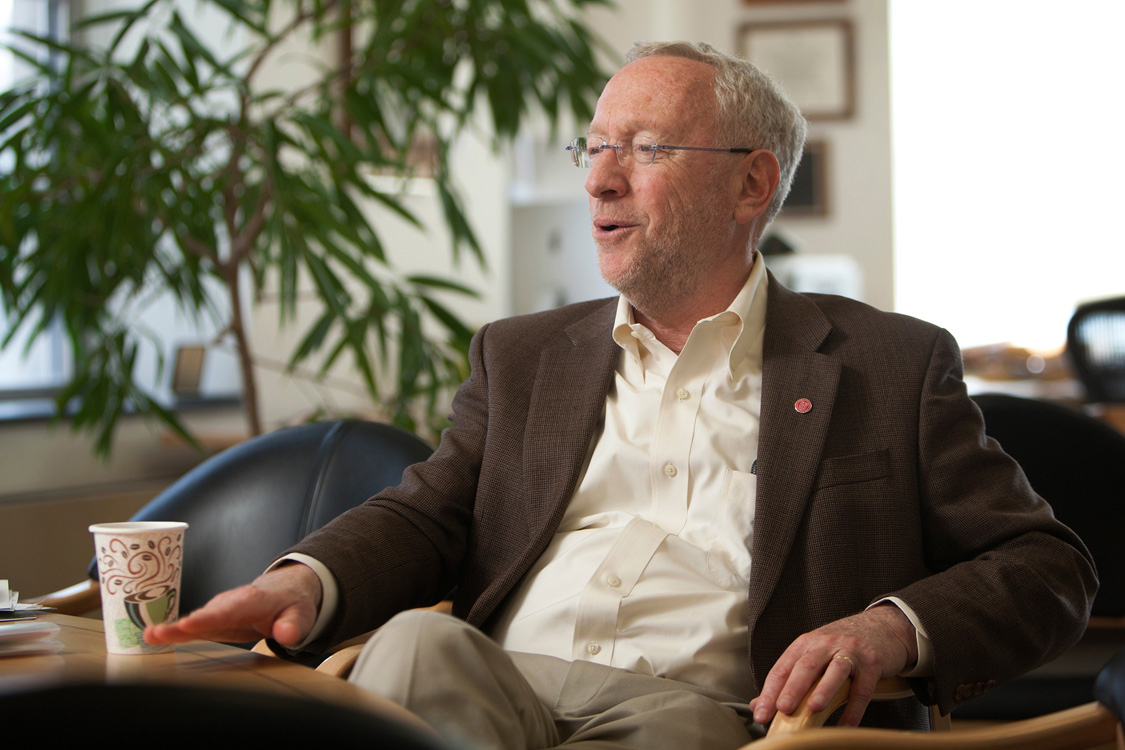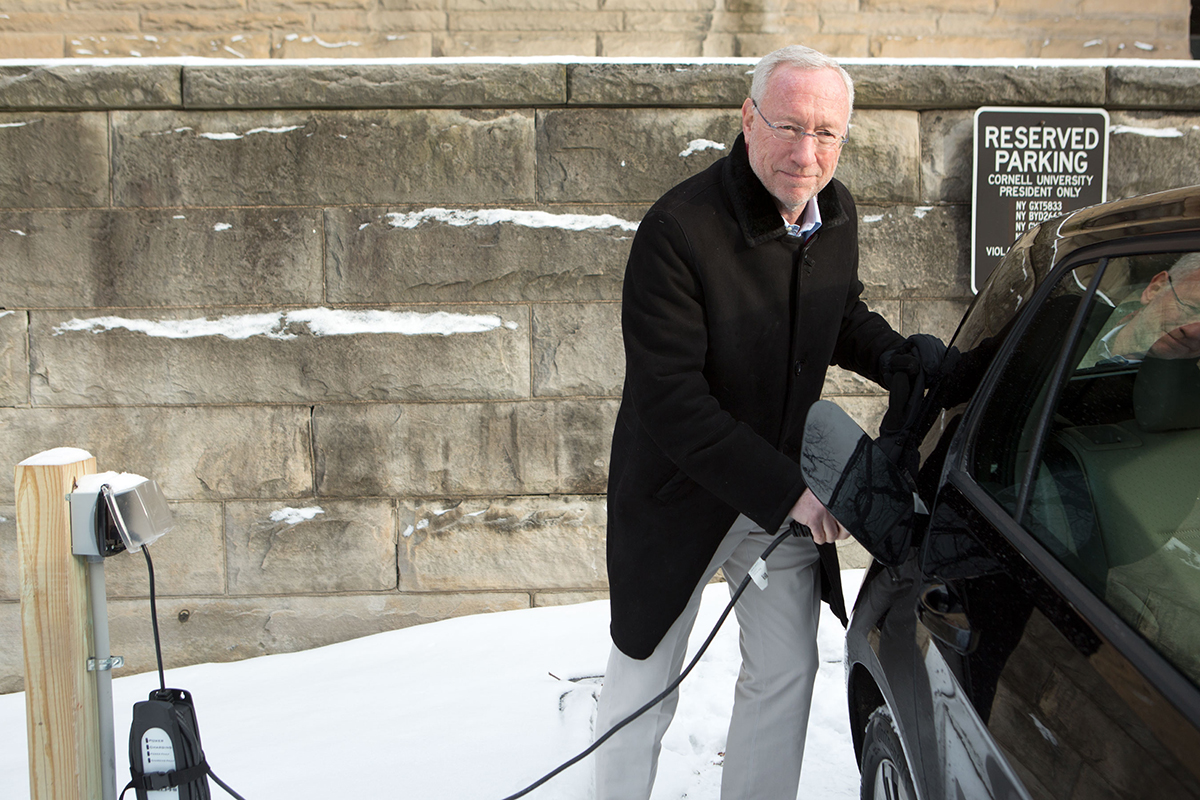Kotlikoff Q&A: Next steps toward campus carbon neutrality
At the request of Provost Michael Kotlikoff, the Cornell Senior Leaders Climate Action Group last fall submitted its report exploring the feasibility and costs of energy and heating options for the Ithaca campus to achieve carbon neutrality by 2035. Here, Kotlikoff discusses the report and the university’s next steps.

What are your reactions to the report?
As I expressed to the Senior Leader Climate Action Group members in a recent letter, I am grateful for their leadership in developing the options report. Creating this detailed financial analysis of climate-neutrality options for our campus was no small task. The report provides an essential menu of options that enable us to make decisions for achieving climate neutrality based on actual costs in relation to our academic mission.
As a large research institution with energy-intensive facilities in a cold climate, we face significant challenges to the elimination of our carbon footprint. However, Cornell has a history of addressing great challenges, and this report provides us with the best thinking of our faculty and staff on how to achieve this goal. I am particularly pleased to see, in addition to the innovative technical approach to heating our campus, more local recommendations that engage all of us. As a community, we must take local as well as institutional action to decrease fossil fuel consumption and increase clean energy production. The report highlights that “business as usual” is not an option for achieving carbon neutrality, and it highlights specific actions that the university should pursue. But I would also stress the importance of each of us endeavoring to lower our carbon footprint.
The report recommends the university pursue Earth Source Heat (enhanced geothermal) to heat the campus. Why would the university pursue this option over more developed technologies?
One of the biggest obstacles to reaching carbon neutrality in a cold-weather climate is the elimination of fossil fuel-dependent heating. Currently, our campus is efficiently heated by a central, gas-powered cogeneration plant that generates electricity as well as the steam that is circulated to most of our buildings. Replacing this plant is our major goal, as doing so will enable us to eliminate direct fossil fuel consumption. Electricity generation can be replaced by renewable sources – and we are expanding these at an impressive rate – but replacing our steam heat system is a larger challenge. Earth Source Heat, coupled with circulated hot water rather than steam, is an exciting technology that has the greatest potential for replacing our co-gen plant and has the highest likelihood of attracting investment partners that would defray the significant cost of its implementation.
Community forum
The Senior Leaders Climate Action Group will host a forum to discuss the options report with the Cornell and Tompkins County communities March 28 from 4:30-6 p.m. at The Hotel Ithaca, 222 S. Cayuga St., Ithaca.
Exploring new and emerging technologies is at the heart of Cornell’s research mission. We have a commitment to search for knowledge-based solutions to societal problems, and one way to do this is through our “living laboratory” model, in which we apply our academic and research ingenuity to pioneer new solutions that impact people’s lives. If we are successful in implementing Earth Source Heat in this region, we will not only solve our greatest heating challenge, but also provide an example of new, renewable technology with broad applications.
Can Cornell achieve carbon neutrality without implementing Earth Source Heat?
Due to the scale of our heating needs and the cost of business as usual, Earth Source Heat – combined with solar, wind and energy-efficiency measures – is clearly the most promising option for achieving carbon neutrality on the Ithaca campus by 2035. The other solutions identified in the report are applications that will not generate new knowledge and will be enormously costly to implement and maintain.
We will know within a few years if Earth Source Heat is truly feasible as a campuswide utility. If it is not, we will re-evaluate options including the use of ground-source heat pumps and other renewables in place of natural gas heating. Energy technologies are advancing at a rapid pace, which means that current, low-carbon options can become more efficient, and new options may well arise.
What are the next steps for Earth Source Heat?
The College of Engineering, in partnership with the Division of Infrastructure, Properties and Planning, has started the initial planning phase, including research on the geology of our region. Dean Lance Collins is actively working to raise awareness and funds from private and government entities. Additional research and funding for preliminary activities must be secured before we would begin any formal phases of the project.
What actions can the university take to address nonheating climate challenges?
Cornell already has made substantial gains in many areas. Over the past decade, our Ithaca campus has grown by more than 2 million square feet, but energy consumption has actually decreased thanks to improving building energy efficiency and the Energy Conservation Initiative driven by ingenuity and engagement from faculty, staff and students who share the urgency to make a difference on campus.
The recent campuswide LED lamp replacement project resulted in reducing peak electric load by 1.5 MW or 5 percent. The lighting project is projected to save $635,000 in annual energy expenses and will reduce ongoing lighting maintenance costs by more than 50 percent.
In the few months since the options report was released, three new Cornell solar farms went online, accounting for nearly 7 percent of our electricity. Additional savings in excess of $150,000 were gained through conservation efforts made over the 2016 winter break. We are making considerable progress.
How can behavioral changes help to reduce the campus carbon footprint?

These efforts have been shown to have an enormous impact, and several colleges have implemented energy-reduction challenges. Powering down computers and other devices, turning off lights and reducing fume hood use where possible, improving our building standards, participating in a bike-sharing initiative that will relaunch later this spring, and using rapidly improving electric or hybrid vehicles to commute will take us one step closer to achieving carbon neutrality on the Ithaca campus. In addition, we are looking for opportunities to build on the success of the Think Big, Live Green campaign to further develop and deploy training tools to reduce energy consumption. Finally, I would urge all of us to try to reduce our personal fossil fuel consumption. Carolyn and I have made this personal commitment – we commute to work in an all-electric vehicle that is charged by a solar panel, which generates enough electricity to entirely power and heat our home. Many faculty have made similar commitments, and I urge all of us to do what we can to join this effort.
Helping to ensure that all students, faculty and staff are climate literate can also have a significant impact. Climate literacy for students begins during their first days on campus, with orientation sessions focused on sustainability. In addition, for the past three years new students have been surveyed to gauge their climate literacy. Exiting seniors will be asked to take a complementary survey, which will help measure behavior change and determine the level of sustainability and climate literacy gained throughout the undergraduate experience.
How will the university achieve carbon neutrality while staying true to its academic mission?
As an institution, we must make all decisions based on costs and benefits in the context of our academic mission and role as a global thought leader. Many of our faculty are highly engaged in sustainability and climate research and teaching, and these topics are pervasive across disciplines. Several of the projects identified in the report will offer faculty and students additional research opportunities to create, test and demonstrate solutions to climate challenges. Creating solutions to challenging and complex issues is part of our research mission and land-grant heritage. We must continually review our options and priorities as we seek to provide to the highest quality, cost-effective education for our students.
What is next for the Senior Leaders Climate Action Group?
The Senior Leaders Climate Action Group can play a key role in continuing to facilitate conversations about the realities of the expense and feasibility of what we are trying to do. I have encouraged the committee to partner with the various organizations already working in this area, including the President’s Sustainable Campus Committee, the Climate Action Advisory Group, the Atkinson Center for a Sustainable Future, Engaged Cornell and others, to engage all members of our community to advance campus sustainability initiatives.
Media Contact
Get Cornell news delivered right to your inbox.
Subscribe